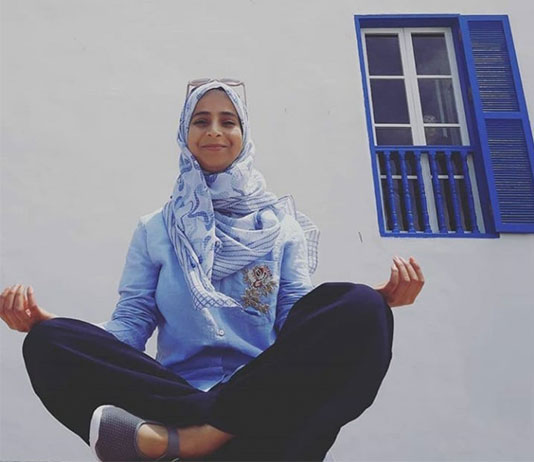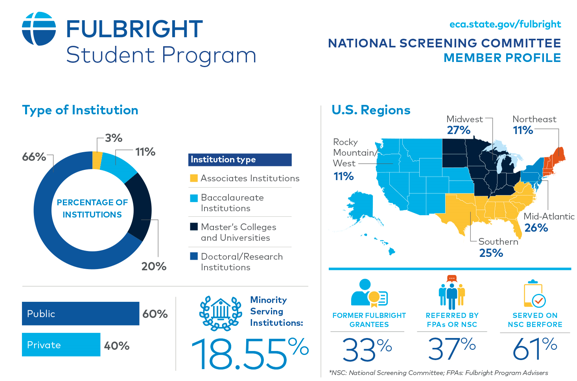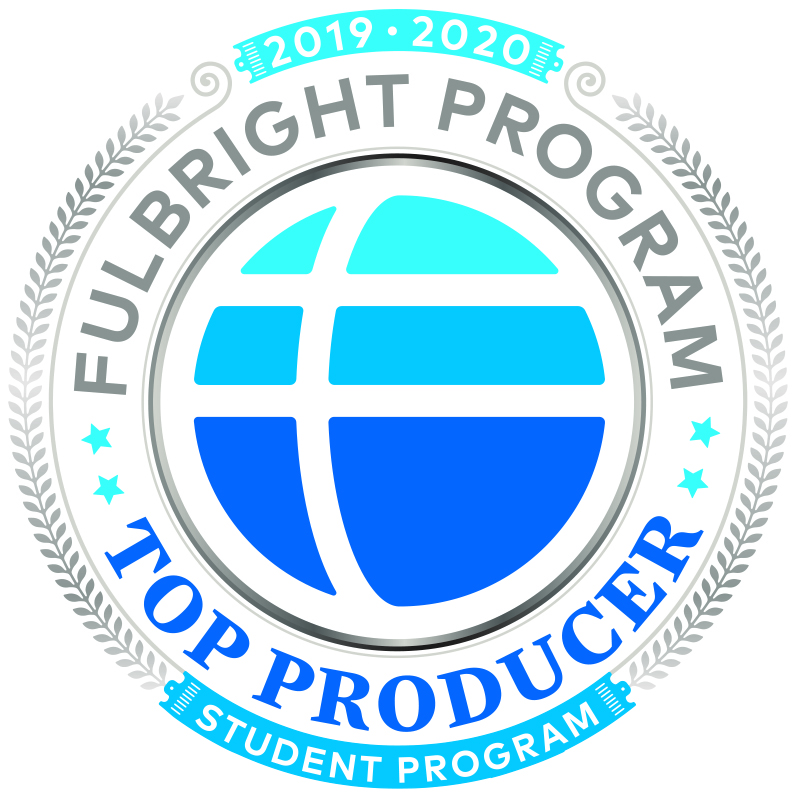This Arabic Language Day, we’re highlighting the contributions of outstanding Fulbrighters who live the Fulbright mission through sharing Arabic language and culture. In this Q&A, Fulbright Foreign Language Teaching Assistant Chama Bououd, an Arabic language FLTA at Stetson University, shares her experience teaching remotely, her tips for learning a foreign language, and what her students have learned about Morocco.
1. Tell us a little about your path to Fulbright. Who or what inspired you to apply?
Chama: My name is Chama Bououd. I am from Morocco and a native speaker of Arabic. I also speak French and English. I am interested in learning from other people and curious about other cultures. I believe that, now more than ever, we need to communicate and exchange our cultures and look from another’s perspective. I saw an opportunity in the Fulbright FLTA Program to experience American culture and share my own culture and native language, and was inspired by Fulbright’s mission to promote mutual understating of cultures and people.
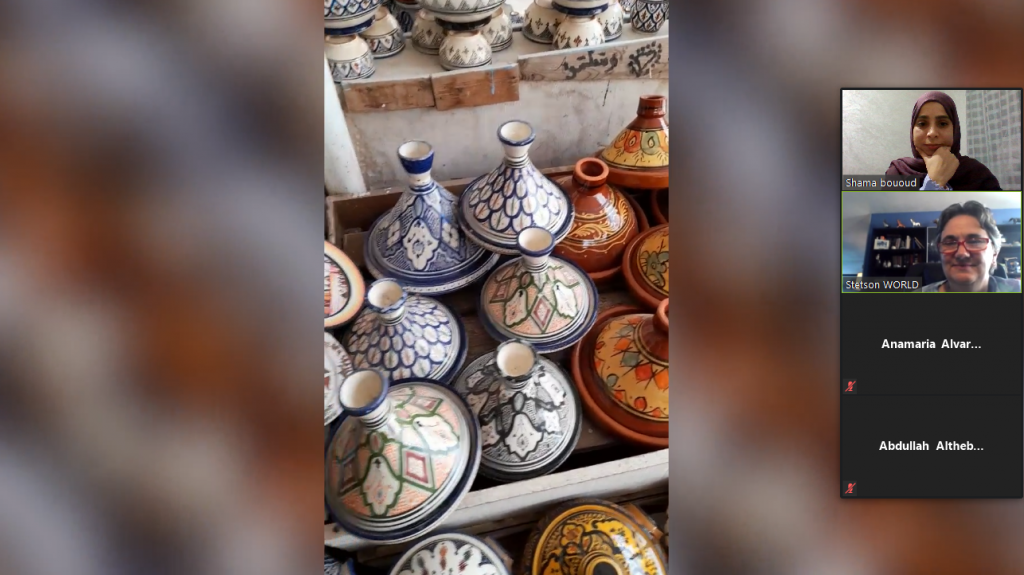
FLTA Chama Bououd introducing the Moroccan tajine, an earthenware pot and dish, to her Arabic class.
2. What tips and tricks have you learned for teaching a foreign language remotely? How have you engaged your students?
Chama: I had to teach remotely from home for the Fall 2020 semester. It was my first time studying and teaching online: teaching a language online is a bit demanding and can be challenging, but the primary instructor, my students, and I made it work. We did our best to cope with the circumstances and we succeeded. I tried to be creative during the classes, recording videos, using my hands and body language to explain and to overcome constraints. I shared Arabic culture, including funny expressions, music, videos, and through conversations, in order to engage all students, especially those beginning to study the Arabic script.
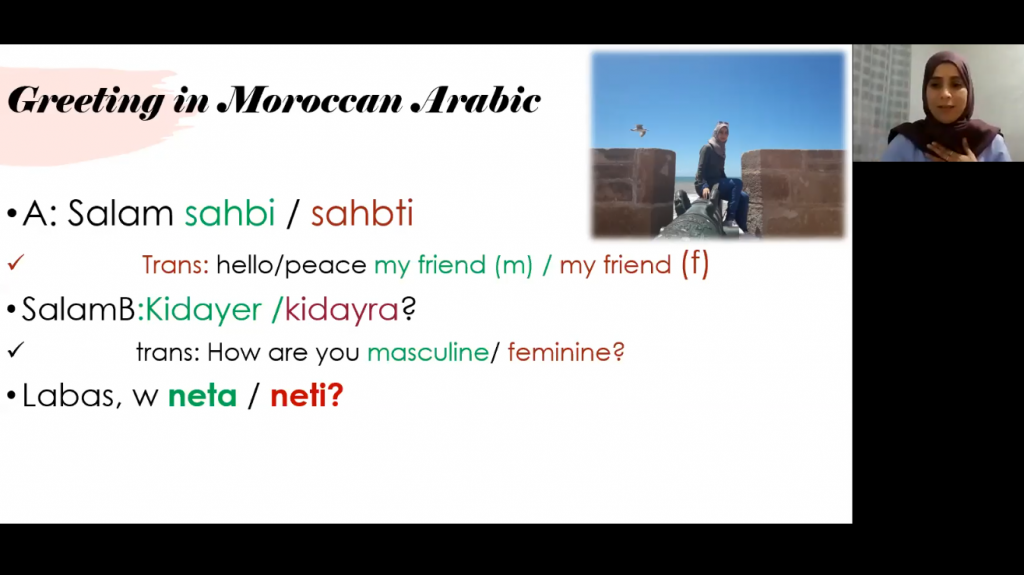
Chama teaching Arabic greetings for a beginning Stetson University Arabic language class.
3. What advice would you give to Arabic language learners, especially those learning via the internet?
Chama: For someone learning Arabic, I would recommend listening to Arabic music, watching movies, following pages that share Arabic content on social media, and watching Arabic videos on YouTube, etc. This enables learners to hear Arabic within context, and to see that Arabic exists beyond class and textbooks, especially for learners who do not live in an Arabic-speaking community. Besides, exposure to a foreign language improves learning, and no language can be learned in isolation from its culture.
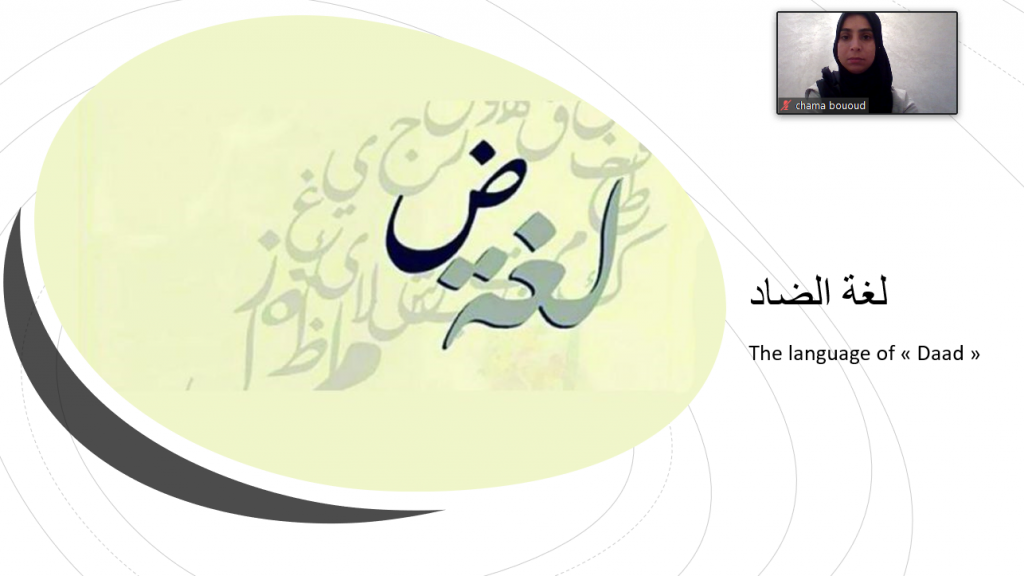
Chama introducing the Arabic letter “daad” to her Arabic class.
4. What might an American be surprised to learn about your home country?
Chama: I noticed that some of my American students and classmates thought that all Moroccan women cover their heads with a hijab, or that we were only allowed to wear black. I explained to my students about Moroccan hospitality, and they were surprised to learn that a host will keep offering guests food, and won’t take “no” for an answer. This is not to be imposing, but rather to be hospitable. I also explained that when shopping in Morocco, you must bargain: the actual price of the product might be half of what the seller is saying, because they expect the customer to bargain.
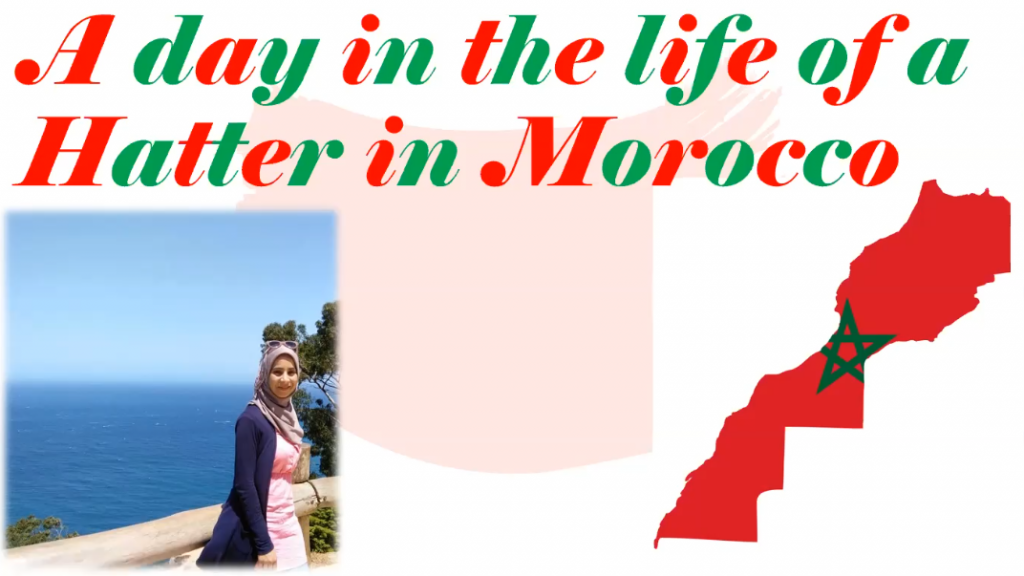
Chama’s presentation on Moroccan Hatters.
5. What is your biggest takeaway from your Fulbright Program?
Chama: My experience in the Fulbright Program has enabled me to look at the world from a different perspective. I have met so many wonderful and helpful people who have welcomed and supported me. I have made connections and learned a lot from my students and classes at Stetson University—this will definitely help me with my academic career and future plans.
Top 5 Fulbright Student Blog Posts of 2020
December 10, 2020By Uyanga Erdenebold, 2007 Fulbright Foreign Student from Mongolia
It stands clear and vivid in my memory as if it were yesterday. It was the clear, sunny morning of August 20, 2007 when I stood at the airport in Ulaanbaatar, Mongolia, equal degrees excited and nervous, surrounded by my family and getting ready to cross the globe to go to a country that I knew only from movies and books. As surreal as it seemed, I knew that this was the shining moment of my triumph. This was the moment I had worked for, and this is the moment that many, even myself, doubted would ever come. I had done it. I was going to the United States as the first-ever blind Fulbright Foreign Student from Mongolia. Though none of us knew at the time, this was to be the beginning of a long, transformative journey, and my relationship with the United States.
When I was 14, an American woman came to our school voluntarily and asked to teach interested students English. What struck us most was the fact that she was blind, just like us. To this day it amazes me how courageous she was to come so far from home all by herself. She ignited the first spark in me of the possibility of doing the same: traveling somewhere far and foreign and being bravely independent. She, not just by teaching me English but also by just being there, showed me that it could be done, and that I too could do it. She helped me to believe, and I was already halfway there.
Fulbright helped me to see the world, and the experience not only changed the course of my life, but more importantly, it changed me as an individual.
It freed me, quite literally, both in the physical and intellectual sense. Until I came to the United States, I had never gone anywhere by myself. I had never learned to walk with a cane. I was always accompanied either by a family member or a friend. Do you know what a privilege it is to be able to walk alone with your thoughts, stopping whenever or wherever you want to, taking as long as you would like to reach a certain place, just to wander around by yourself? That’s what the United States gave me: personal freedom. It was there that I first owned my own key to my apartment. Once I completed my cane training, I quickly moved on to guide dog training, and received my first guide dog in August 2008. My partnership with my first guide dog, Gladys, was one of the most positive, heart-warming, and transformative experiences of my life, and for this, I’m forever grateful to the United States.
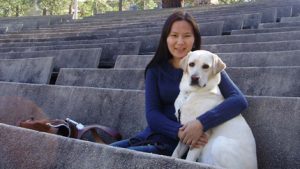
Fulbright Foreign Student Uyanga Erdenebold with her guide dog, Gladys.
I was never defined by my disability, even before I came to the United States. However, before then, I was defiant, always seeking to prove my worth. What the United States taught me was that I was already an equal, an acknowledged human being with the same right to contribute to society as everyone else. This liberated me from a huge burden I had carried all my life. Now I could focus on my studies just like everyone else. I would have been fine if my professors felt differently, especially with assignments and readings. But as far as they were concerned, the only difference between the other students and myself was that I had a pretty dog.
There were difficult days, of course, especially in the beginning – days when I wondered why I left the comfort of my home and my family and friends. I felt lonely, homesick, and frustrated. But those feelings are only natural. Remembering how hard you worked to get where you are and what you hope to achieve with this experience helps shed a different light on everything.
Once, a journalist asked me what I thought was the hardest thing in my life, and I said, “Not being able to contribute.”
The basic elements of a fulfilled human life are to be relevant, to be able to contribute, and to be acknowledged. Every human experience, all human knowledge, and every human feeling finds meaning only when shared. When you are judged not by the merit of who you are, but by the perceived limitations of your disability, your right to contribute quickly gets turned upside down and becomes a right to receive. If you don’t contribute, you become irrelevant and forgotten. The unfortunate truth is that society has a tendency to generalize and apply their notions of perceived limitations on you based on a lack of certain sense or physical attribute. But is ability determined by one’s physical attributes alone? A truer indicator of ability might be experience.
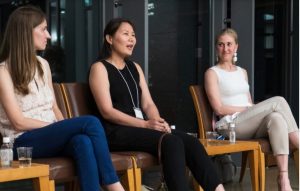
Uyanga Erdenebold speaking at a WomEmpowered International event in Tokyo, Japan.
Many people with disabilities usually have been told to be “realistic” in life, and have always had to prove themselves in order to get any type of recognition and value. People always assume incompetence, and it’s always on the person with a disability to prove them wrong. To have to do that with everyone you meet is incredibly exhausting. It’s similar to being forever on trial, where everyone you meet is the jury and you’re always assumed guilty—in other words, incompetent—until proven otherwise.
My one piece of advice to everyone working with a person with a disability is: ALWAYS ASSUME COMPETENCE.
Be willing to give trust and confidence without proof. Be willing to be the ally and not the jury. Be willing to go the extra mile even if it seems futile. What society expects from disabled people is to have such strong inner self-will and awareness that we can propel ourselves forward, even when everyone we meet always expects less from us compared to our non-disabled peers. For anybody, going to college and having a job is a normal part of life, and it’s expected as a matter of course. However, when those with disabilities achieve those same things, it’s a great success and an exception to be applauded. Why? Precisely because we are not expected to be able to do those things.
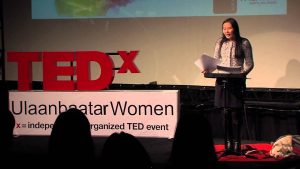
Uyanga Erdenebold presenting at TEDx UlaanbaatarWomen.
Before I went to the United States, I often arranged my life and my dreams to accommodate my disability. But after my Fulbright experience, I let my disability accommodate my life. I learned that there is much more to life than what meets the eyes, and there are endless opportunities if I only allow myself to find them.
Making the Grade: Five Things Every Applicant Should Know About the Fulbright U.S. Student Program Review Process
October 15, 2020By Fulbright Program Staff
Congratulations on submitting your Fulbright application! Now what? Have you ever wondered what happens to your Fulbright application after you hit “submit”? In this post, we’ll shed light on the Fulbright U.S. Student Program’s technical review and National Screening Committee (NSC) processes, illustrating how an applicant becomes a Fulbrighter.
1. First things first… Technical Review
After you hit “submit,” Fulbright Program staff first conducts a technical review of your application materials. Therefore, it pays to thoroughly review country descriptions and eligibility criteria at the beginning of your application journey to ensure that you meet all requirements. Check out our handy application checklist to make sure you don’t forget to include any application materials, too.
During our technical review, we double-check your biographical data, citizenship, transcripts, letters of recommendation, project plans, and more for eligibility and completeness. Make sure that ALL required materials are successfully uploaded and viewable in your online application portal—you won’t be able to add missing documents later! (Hint: Be sure to view and save a PDF copy of your application before submitting—you’ll have both a copy of your application for your records and be able to confirm that all documents are successfully submitted and readable!)
After confirming an application is eligible and complete, it is moved to the National Screening Committee (NSC) for review.
2. The NSC: The Reviewers (and What They Are Looking For)
During “NSC Season,” almost 200 committees meet to review and discuss all successfully submitted applications. Each application is sent to a committee of three reviewers a.k.a. NSC members, for a transparent, merit-based review process.
Who exactly are these reviewers? The individuals that review your application are typically university professors with expertise in either a) your academic/professional field, or b) the country or world region where you propose undertaking your Fulbright. Many are Fulbright alumni, while others have been recommended by Fulbright Program Advisers or other NSC members. Reviewers reflect the diversity of the U.S. higher education community and include panelists from minority-serving institutions (MSIs), Historically Black Colleges & Universities (HBCUs), and other underrepresented institutions.
Each committee reviews approximately 60-70 applications in advance of a meeting, scoring each submission based on specific review criteria. While all programs and applicants are unique, NSC reviewers look for well-researched, feasible research and community engagement projects, adequate academic and personal preparation for the proposed country or award, and personal attributes and qualities that illustrate a positive and passionate cultural ambassador of the United States to the world. Be authentically you!
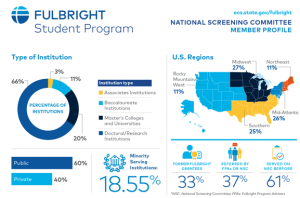
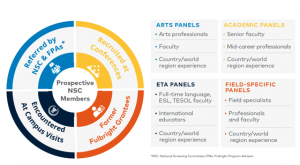
3. NSC Review Day
Throughout November and December, NSC reviewers gather for review meetings. Committees consist of three reviewers and one staff facilitator who directs the flow of the meeting, answers reviewers’ questions about the Fulbright Program, and records results. At these meetings, reviewers discuss each application using a collaborative approach and are welcome to adjust their scores based on their conversation. At the end of the meeting, final scores are tabulated by the staff facilitator, determining which candidates the committee recommends for further consideration during the host country review process.
4. Time & Consideration: The Breakdown
As you may have gathered, the NSC process is a massive undertaking! In 2019, 525 NSC members reviewed approximately 10,400 applications at 175 committee meetings in 6 different cities. From start to finish, more than 11,000 hours are spent screening, reviewing, and scoring each application. And that’s before the in-country review process!

5. The Decision
Based upon the NSC process, applications are designated as “Recommended” or “Non-Recommended.” All applicants are notified of their application’s status, and recommended applicants become “Semi-Finalists!” Recommended applications are forwarded to their respective Fulbright host countries for an additional round of selection, taking into account Fulbright Commission and U.S. Embassy priorities. During this period, Semi-Finalists undertaking research or graduate degree programs may be asked to submit letters of acceptance or affiliation from their proposed institution, so it’s important to receive all necessary documents as soon as possible. In some cases, host countries may also choose to contact Semi-Finalists for short phone or video chat interviews, in order to get a better sense of the person behind the application.
After months of concentrated effort by both applicants and Fulbright Program staff, host countries will share final application notifications on a rolling basis between February and May. Successful applicants are sent an award offer, and are officially known as “Finalists.” Qualified applicants not selected as Finalists may become “Alternates,” or potential awardees that may receive an award offer, should additional funding become available. Non-selected applicants are encouraged to celebrate their Semi-Finalist status, and reapply for the next award cycle. Even those who are not selected should feel extremely proud of their efforts, and know that many parts of the application can be applied to future endeavors beyond Fulbright, such as applying to graduate school.
The Fulbright U.S. Student Program application process is undoubtedly long. We hope this article provides some clarity into the process, and helps you create the best application you can. In writing, editing, and discussing your candidacy with friends, mentors, Fulbright Program Advisers, and other individuals, you may gain greater insight into your passions, your reasons for pursuing a Fulbright, other transferable skills you possess, and insight into our world. Our best wishes for a successful application and bright future!
How to Build a Fulbright Top-Producing Institution: Northwestern University
September 3, 2020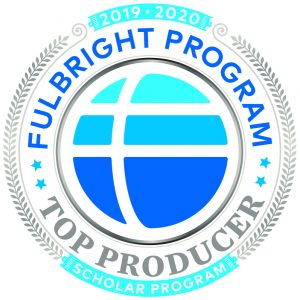
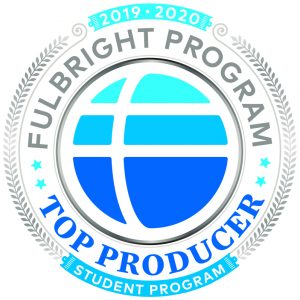
What makes a “Fulbright Top-Producing Institution“? A variety of institutions discuss their efforts to recruit, mentor, and encourage students and scholars to apply for the Fulbright U.S. Student and U.S. Scholar Programs. We hope these conversations pull back the curtain on the advising process, and provide potential applicants and university staff with the tools they need to start their Fulbright journey.
“At Northwestern University, we believe that relationships fuel knowledge. Collaborations among individuals and institutions, globally and locally, drive new discovery and innovation. Fulbright offers a platform to build new relationships and deepen existing partnerships in order to work together to identify new solutions to address the world’s most critical challenges.”
By Northwestern University Staff
Question: Your outstanding faculty/students are one of many factors that led to this achievement. What makes your faculty/students such exceptional candidates for the Fulbright Program?
Our campus is both international- and service-oriented. Northwestern students work, live, and study with students from around the globe. Similarly, our faculty as a whole is deeply international in their background and their outlook. Our students confront and embrace the concept of “difference” daily and are comfortable asking questions that do not have easy answers. We have robust connections with our language faculty who participate on panels and promote the Fulbright Program to their students. Further, a spirit of service pervades this campus. It is rare to find a student who is not actively engaged in socially focused extracurricular activities. Add in the rigorous intellectual climate at Northwestern, and the result is that students are engaged with the world, have empathy for and curiosity about all people, and possess an inquisitive disposition—which, essentially, makes them great Fulbright applicants.
Northwestern’s many strengths are amplified by our culture of collaboration; our research and learning culture is deeply multidisciplinary. In a world where the greatest innovations are produced by teams, not individuals, Northwestern faculty and students are prepared to engage across disciplines and with international partners. This makes them excellent candidates for Fulbright awards because they approach the opportunity already coming from a culture of collaboration across boundaries of all kinds.
What steps have you taken to promote a Fulbright culture on your campus?
We work to keep Fulbright in front of students year-round. We joke that it is “always Fulbright season,” but this is more than a little true. Beginning with the national deadline, we communicate directly with last cycle’s non-recommended applicants and those who began, but did not finish, the application. We see both cohorts as likely candidates for the next cycle. Further, those students who go through our application process are our best advertisement! Our process really gets underway in January with a series of informational meetings which then morph into application workshops in May and June (Northwestern operates on a quarter schedule). In addition to specific Fulbright-focused events, nearly every conversation with students or presentation about fellowships uses Fulbright as an example. During the summer, students work closely with a Fulbright Program Adviser, whom we assign. This close relationship is in addition to their departmental mentors and cements their engagement with our office and the Fulbright application process.
How has your institution benefited from increased engagement with the Fulbright Program?
Northwestern University has been a consistent Fulbright Top Producing Institution for over a decade. Thanks to this record, most students and their faculty mentors see Fulbright as an excellent opportunity to further their interests. We are blessed with a good word-of-mouth network, which encourages students to develop an international outlook early in their education. Fulbright is a well-established aspirational goal for our students, and they see that their chances of receiving an award is within their grasp. They begin on-campus research experiences and language study knowing that developing these skills will help them to extend their local goals onto a global stage.
How does your institution support faculty and administrators who apply to the Fulbright Program?
For administrators who wish to apply to the Fulbright Program, Northwestern’s Office of International Relations promotes the opportunity and provides editorial feedback to staff on their applications.
For faculty, we connect prospective applicants with colleagues who have had Fulbright awards or who have hosted Fulbright representatives on campus and facilitate faculty members’ efforts to bring colleagues with Fulbright grants to campus when possible.
Find out more information about the ways that Northwestern connects with the Fulbright Program here.
What advice do you have for other universities and colleges that want to increase the number of Fulbrighters produced by their institution?
Success with the Fulbright Program starts with an internationally focused institution and strong faculty support. While individuals working with Fulbright applicants might not be able to single-handedly internationalize their campus, they can help faculty see the value in this program and in global opportunities as a whole. Through advertising, individual meetings, group meetings, and conclaves with appropriate faculty, an adviser can facilitate that moment when a faculty member taps a student on the shoulder and says, “You know, you should apply for a Fulbright.”

